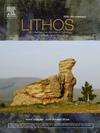Deep-crustal layered mafic complexes in the Mesoproterozoic oceanic-arc of the Tugela Terrane, South Africa
IF 2.9
2区 地球科学
Q2 GEOCHEMISTRY & GEOPHYSICS
引用次数: 0
Abstract
Layered mafic intrusions are important in understanding the generation of continental crust in oceanic arcs. The Mesoproterozoic (c. 1200 Ma) Tugela Terrane in southeast South Africa is made up of a series of thrust slices of varied rock-types purported to have been derived in oceanic arcs prior to accretion onto the southern margin of the Archean Kaapvaal Craton. They are not ophiolites. Mafic intrusions in two adjacent thrust slices are known as the Tugela Rand and Mambula Complexes. Both intrusions are intensely layered on scales of centimetres to several tens of metres but clear cyclic units are not apparent and crystal fractionation is limited indicating these were open systems with magma chamber through-flow. Tugela Rand is made up of dominantly olivine-bearing rocks ranging from dunite and pyroxenite to gabbro. In contrast, Mambula is dominantly gabbroic with only rare olivine-bearing rocks and is more evolved with layers of titaniferous-magnetite. Primary magmatic structures in both complexes include graded bedding, slumping and erosion features. Relatively high pressure of formation is indicated by the aluminous nature of the pyroxenes and corona textures by reaction between plagioclase and olivine. Chromitites in Tugela Rand range from massive to podiform with the rare orbicular variety indicating complex controls on chromite accretion. They include the high-Al compositional variety. There are no other similar chromitite occurrences in South Africa. The complexes, together with their enclosing rock-types, draw striking parallels with the lower arc crust observed in the late Cretaceous Kohistan arc complex in NE Pakistan. The Tugela Rand Complex shares many similarities with the Chilas Complex in that terrane, while the Mambula Complex is considered to be a more evolved derivative of the same magma. This study shows that generation of juvenile continental crust formation in mature island arc systems may have been firmly established by the Mesoproterozoic.
南非图盖拉地体中元古代大洋弧深部层状基性杂岩
层状基性侵入体对于理解大洋弧中大陆地壳的形成具有重要意义。南非东南部的中元古代(约1200 Ma)图格拉地体是由一系列不同岩石类型的冲断片组成的,这些岩石类型据称是在太古宙Kaapvaal克拉通南缘增生之前在海洋弧中形成的。它们不是蛇绿岩。两个相邻逆冲断层中的基性侵入体被称为图格拉-兰德和曼布拉杂岩。这两种侵入体在厘米到几十米的尺度上都有强烈的层状,但明显的旋回单元不明显,晶体分异有限,表明它们是具有岩浆房贯穿流的开放体系。图格拉兰德主要由含橄榄石的岩石组成,从泥质岩、辉石岩到辉长岩不等。相比之下,曼布拉主要是辉长岩,只有罕见的含橄榄石岩石,更多的是钛-磁铁矿层。两个杂岩体的原生岩浆构造均具有层理、滑塌和侵蚀特征。辉石的铝性质和斜长石与橄榄石反应形成的日冕结构表明其形成压力相对较高。图格拉兰德的铬铁矿从块状到足状不等,罕见的圆形品种表明铬铁矿增生的复杂控制。它们包括高铝成分的品种。在南非没有其他类似的铬铁矿。这些杂岩连同它们的包裹岩石类型,与在巴基斯坦东北部晚白垩世Kohistan弧杂岩中观察到的下弧地壳有着惊人的相似之处。图格拉兰德杂岩与该地块的奇拉斯杂岩有许多相似之处,而曼布拉杂岩被认为是同一岩浆的更进化的衍生物。该研究表明,成熟岛弧体系的幼年大陆地壳形成可能在中元古代就已牢固确立。
本文章由计算机程序翻译,如有差异,请以英文原文为准。
求助全文
约1分钟内获得全文
求助全文
来源期刊

Lithos
地学-地球化学与地球物理
CiteScore
6.80
自引率
11.40%
发文量
286
审稿时长
3.5 months
期刊介绍:
Lithos publishes original research papers on the petrology, geochemistry and petrogenesis of igneous and metamorphic rocks. Papers on mineralogy/mineral physics related to petrology and petrogenetic problems are also welcomed.
 求助内容:
求助内容: 应助结果提醒方式:
应助结果提醒方式:


